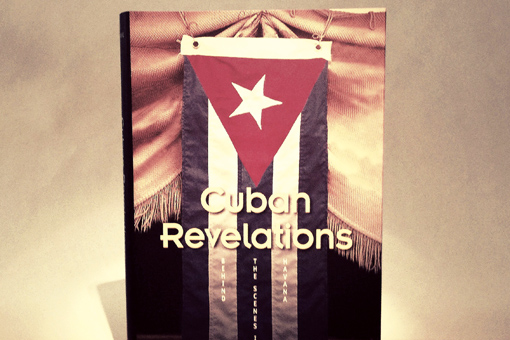Popular interest in Cuba will continue to grow as Americans open their eyes and ears to one key fact: after 55 years, Cuba is changing. It is shifting from a highly centralized, paternalistic, socialist regime, both lauded and vilified for achieving social progress at the cost of democracy and civil liberties, to a hybrid system in which individual initiative, decentralization and some forms of limited debate are encouraged. As the Castro brothers prepare to leave the scene, they are handing power to a more institutionalized Communist party that maintains tight political control even as it liberalizes the economy.
Marc Frank’s new book, Cuban Revelations: Behind the Scenes in Havana, expertly captures this evolving terrain. He provides a clear and compelling guide to the transition from Fidel to Raúl Castro after the demise of the Soviet Union. Frank, currently a freelance journalist for Thomson Reuters and the Financial Times, deploys his two decades in Cuba and his extensive network of colleagues, friends and family (he is married to a Cuban) to explain to both seasoned and amateur observers why Cuba’s leaders are embarking on a new path.
This is no easy assignment. Nearly everything about life in Cuba today is complicated by Cuba’s outsized role during the Cold War, the trauma of exile and the opaque nature of its regime. Despite Cuba’s controlled media environment, Frank managed to open doors to information not readily available to others, a testament to his intrepid reporting.
Frank focuses on the Cuban regime’s recognition that it needed a “blueprint for survival” to cope with the barrage of challenges it faced in the 1990s and afterward with the withdrawal of Soviet subsidies and assistance, the tightening U.S. embargo, a heavy debt burden, and a few major hurricanes. The author quotes Raúl’s address to the National Assembly in August 2009 as evidence of the intellectual shift from a revolutionary ethos to pragmatic governance. “No one, neither a person nor country, can endlessly spend more than they earn,” Raúl said. “In the conditions of our imperfect socialism, due to our own shortcomings, quite often two plus two makes three. We should definitely put an end to the irresponsible attitude of consuming while no one, or very few, care to think of how much the country pays to ensure it and, foremost, if it can really do it.”
Frank chronicles how the government’s efforts to “replace social, across-the-board subsidies with individual reward and targeted welfare,” has meant difficult adjustments for most Cubans: the closure of lunchrooms, a steady drop in the value of the monthly rations allotment and layoffs of hundreds of thousands of government workers (the majority of Cuba’s workforce). Frank catalogues the decline in the quality of public services such as housing, education and health care—once hallmarks of the revolution—and the steady rise in prices of goods.
There have been, Frank says, liberalizing measures as well—such as the expansion of the “cuentapropista” or self-employed sector and a consequent proliferation of food and other small business vendors. Agriculture policy has also been revamped to encourage more cultivation of arable land and direct sales to markets, restaurants and hotels, instead of through the Cuban bureaucracy. Decision making has become more decentralized, with local and provincial governments and party committees gaining some control over economic decision making. Cubans have also been allowed to buy and sell their houses and cars (84 percent of Cuban households own their homes), a move that effectively legalizes and taxes a pre-existing black market increasingly driven by market economics.1
To help cope with these adjustments, Cubans benefited from the largesse of Fidel Castro’s faithful student, Venezuelan President Hugo Chávez, who happened to control the world’s largest reserves of crude oil right next door. In exchange for heavily subsidized energy imports, Cuban doctors and teachers were sent abroad to work in the barrios and favelas of Caracas and Maracaibo. This has turned out to be a critically important and fortuitous element of the Cuban survival story and deserves more attention than it gets in the book.
No analysis of Cuba’s current predicaments would be complete without understanding the role of the United States. Here, Frank notes that President Obama’s decision in 2009 to loosen restrictions on travel and remittances for Cuban Americans has had a direct positive effect on many Cuban families. But we are only just beginning to understand how these trends are affecting Cuba’s political economy and social dynamics. Many entrepreneurs are now able to start small businesses with cash and goods from abroad—a subject covered in more detail by Richard Feinberg in “Soft Landing in Cuba? Emerging Entrepreneurs and Middle Classes” (Brookings Institution, November 2013). As more Cuban Americans from across the social spectrum visit the island, and as more Cubans take advantage of Havana’s decision in 2013 to make it easier for them to leave and return to their homeland, a
process of dialogue and “humanization” of the long-divided Cuban family is accelerating.
Yet the Castro regime appears in no rush to stop demonizing Washington; nor has it affected the zeal of pro-embargo hardliners in Washington, a subject Frank largely avoids, given his focus (correctly, in my view) on events in Havana rather than Miami.
Frank’s excellent and accessible volume tells us how Cuba is slowly but surely changing, a story largely missed in Washington. Meanwhile, U.S. policy remains firmly wedded to the past. President Obama could do much more to support the Cuban people,2 but seems bogged down in other crises and unwilling to take the heat given Cuba’s poor human rights record and its continued detention of a USAID contractor. Frank’s work forces the question: should the U.S. remain alone at loggerheads with a Cold War enemy, or begin a process of direct, high-level and comprehensive dialogue with Havana coupled with direct support to the Cuban people?




